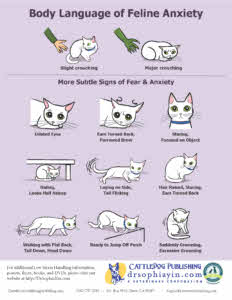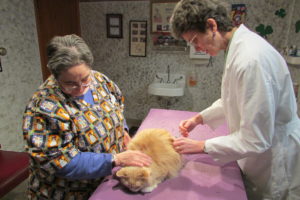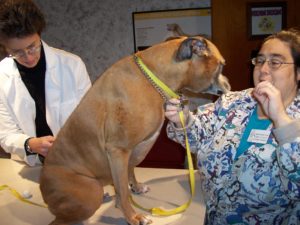When I went through tech school, I was taught that part of my job as a technician was to make sure the DVM did not get injured. If I saw a possible bite coming it was my job to get bit, or to “take it for the vet,” because the vet is the most valuable staff person and could not get injured. In other words, the DVM was considered an all-powerful being to be protected at all costs.
Yes, the DVM is a valued person, but so is the rest of the staff. We all need to work as a team to make things better for the animals entrusted into our care by their owners. In a Low Stress Handling® Certified clinic like mine, communication between the technicians and the veterinarian is crucial to making vet visits as Low Stress as possible.
Technicians and Veterinary Assistants do most of the patient handling and treatments. In doing so, we learn to read each patient’s body language so that we know when to pause during a treatment to allow them to deescalate if they start to get anxious or stressed. Then, once they are relaxed, we continue with completing our necessary tasks.
When the Technician or Veterinary Assistant is assisting the DVM during an exam, or doing any type of care, it is our job to be the patient’s advocate. The Technician or Veterinary Assistant needs to be aware of many things all at once. For instance, we need to be aware of where the veterinarian is in the room, when she is close to the patient, what she is about to do, and what she is currently doing. While we are doing that, we also need to be keenly aware of the patient. We constantly monitor our patient for signs of fear or anxiety. These signs could include sudden tensing of the body, a change in position of the ears (forward, or back, down low, etc.), the state of their mouth (relaxed, tense, panting heavily, changes in their eyes (pupils dilated, wrinkled brow, etc. You can order the posters shown below for handy reference):
In order to prevent injuries to staff, and to make the whole experience better for all involved, it is crucial that we know when to stop what we are doing, and to give the patient time to deescalate before we continue. We can adjust the handling plan or suggest that medication may be needed to decrease the patient’s stress level. There needs to be a very clear understanding and level of trust between the person doing the handling and the veterinarian. Both the vet and staff should agree upon ways to alert the vet to stop what they are doing. You can say “Fluffy is getting more tense” or “Fluffy has stopped taking rewards” – a sign that the patient is feeling increased stress levels. You could even just say “Dr. ______!” in a tone that gets his/her attention without yelling or using a disrespectful tone of voice.
The most important thing to remember is that you are all working together as a team to give your patients a better experience in the veterinary clinic. Do not be afraid to stand up for yourself and your patient. Just be sure to do it in a respectful and professional way. Agree upon key words or phrases before you go into the exam room together. With this approach, you can enjoy being part of a team that delivers the best possible care and attention to their patients.
In this photo this kitty is getting a vaccine. You can see my right hand hovering over the cat’s neck and my left hand ready to move to the back of the cat if necessary. My head is tilted watching the cat and out of the corner of my eye I’m watching every move the vet makes so I know exactly what she is doing. This way I can alert the vet to any changes in the cat’s body language that would indicate a potential bite risk.
Here is Ginger getting an injection. I am using a collar hold with one hand with a treat in the other hand to distract and reward her. I am watching her body language as well and keeping an eye on the veterinarian doing what she needs to do. This way I can alert the vet to any changes in Ginger’s body language that suggests we may need to pause what we are doing.






